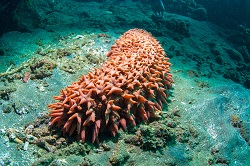First evidence that deep-sea animals are ingesting microplastics
The environmental fallout from plastic microbeads has over recent months has become a pressing political priority. The British government is planning to ban plastic microbeads in cosmetics and cleaning products by the end of 2017. This follows reports by the UK’s House of Commons Environmental Audit Committee that a single shower can result in 100 000 plastic particles entering the ocean. France and the United States have also taken steps to impose their own restrictions. Alarming discovery Now researchers from the universities of Bristol and Oxford, working on the Royal Research Ship (RRS) ‘James Cook’ in the mid-Atlantic and south-west Indian Ocean have found evidence of microbeads inside hermit crabs, squat lobsters and sea cucumbers, at depths of between 300m and 1 800m. In total 9 organisms were studied and microplastics were found in 6 of them. This is the first time that microplastics have been shown to have been ingested by animals at such depth. Microplastics are generally defined as particles less than 5mm in length and include the microfibers analysed in the study and the microbeads used in cosmetics (such as toothpaste and shower gel). Among the plastics discovered in the deep-sea animals in this study were polyester, polypropylene, viscose, nylon and acrylic. Microplastics are roughly the same size as ‘marine snow’, the shower of organic material that falls from upper waters to the deep ocean and which many creatures residing at those depths feed on. Professor Laura Robinson from Bristol’s School of Earth Sciences commented: ‘The result astonished me and is a real reminder that plastic pollution has truly reached the ends of the Earth.’ ‘The main purpose of the research expedition was to collect microplastics from sediments in the deep ocean – and we found lots of them,’ said lead author of the study, Dr Michelle Taylor from Oxford University. ‘Given that animals interact with this sediment, such as living on it or eating it, we decided to look inside them to see if there was any evidence of ingestion. What’s particularly alarming is that these microplastics weren’t found in coastal areas but the deep ocean, thousands of miles away from land-based sources of pollution.’ Reducing contamination risks The animals were collected using a remotely operated underwater vehicle (ROV). This method was chosen to reduce the risk of contamination by surrounding sediments, as well as reduce trauma to the organisms. Using an ROV also ensured that the research team knew the exact location and habitats of the organisms. Stomach, mouth, all internal cavities and breathing organs (gills and ventilation cavities) were dissected from the 9 deep-sea organisms and examined under a binocular microscope to identify whether or not they had ingested or internalised microplastics. Microfibres were classified using a Nikon polarised light microscope, a method commonly used in forensic science and has proven benefits for the fast and effective identification of fibres. The research team also included the Natural History Museum in London and Staffordshire University’s Department of Forensic and Crime Science, which made sure that the results were robust and free from potential contamination. ‘Existing forensic approaches for the examination of fibres are tried and tested for their robustness and must stand up to the scrutiny of the courts of law,’ said Dr Claire Gwinnett of Staffordshire University. ‘These techniques were employed in this research in order to effectively reduce and monitor contamination and therefore provide confidence in the fact that the microplastics found were ingested, and not from the laboratory or other external contaminant.’ The study has been published in the journal ‘Scientific Reports.’ For more information, please see: project page on CORDIS
Countries
United Kingdom



